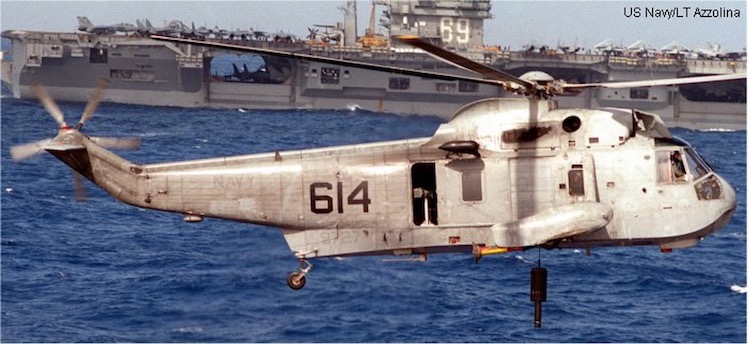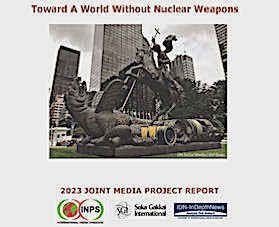By Thalif Deen
NEW YORK (IDN) — A significant spike in arms imports by Europe, East Asia and Oceania during the last five years has reaffirmed the continuously sharp increase in global arms sales—a rising trend undaunted by a faltering world economy or the two-year-long pandemic lockdown. [2022-03-14-31] JAPANESE TEXT VERSION PDF | SWEDISH | TURKISH
According to a new study by the Stockholm International Peace Research Institute (SIPRI) released March 14, Asia and Oceania remained the largest importing region for major arms, receiving 43 per cent of global transfers during 2017–21.
And six states in the region—India, Australia, China, South Korea, Pakistan and Japan—were among the 10 largest importers globally.
"Tensions between China and many states in Asia and Oceania are the main driver of arms imports in the region," said Siemon T. Wezeman, Senior Researcher with the SIPRI Arms Transfers Programme.
“These tensions are also a major factor in US arms transfers to the region. The USA remains the largest supplier to Asia and Oceania, as arms exports are an important element of US foreign policy aimed at China.”
Of the world’s nine nuclear powers, four are in Asia: India, Pakistan, China and North Korea, while the remaining five include UK, US, France and Russia, along with Israel (in the Middle East).
Paradoxically, five of the major nuclear powers—UK, US, France, China and Russia—are also five of the veto-wielding permanent members (P5) of the UN Security Council, whose primary mandate is the maintenance of international peace and security.
But the implementation of that mandate is largely in the hands of the P5—all of them armed to the teeth with nuclear weapons and also massive arsenals of conventional arms, including fighter planes, combat helicopters, drones, missiles, warships, battle tanks, armored personnel carriers and heavy artillery, among others.
SIPRI's latest global arms exports and imports report comes nearly six months after the findings of the SIPRI Yearbook 2021, which assessed the current state of armaments, disarmament, and international security. A key finding is that despite an overall decrease in the number of nuclear warheads in 2020, more have been deployed with operational forces.
"The overall number of warheads in global military stockpiles now appears to be increasing, a worrisome sign that the declining trend that has characterized global nuclear arsenals since the end of the cold war has stalled," said Hans M. Kristensen, Associate Senior Fellow with SIPRI’s Nuclear Disarmament, Arms Control and Non-proliferation Programme and Director of the Nuclear Information Project at the Federation of American Scientists (FAS).
"The last-minute extension of New START by Russia and the USA in February … was a relief, but the prospects for additional bilateral nuclear arms control between the nuclear superpowers remain poor."
According to the SIPRI Yearbook 2021, Russia and the USA together possess over 90 per cent of global nuclear weapons. Both have extensive and expensive programmes under way to replace and modernize their nuclear warheads, missile and aircraft delivery systems, and production facilities.
"Both Russia and the USA appear to be increasing the importance they attribute to nuclear weapons in their national security strategies," said Kristensen.
All the other seven nuclear-armed states are also either developing or deploying new weapon systems or have announced their intention to do so. The UK’s 'Integrated Review of Security, Defence, Development and Foreign Policy', published in early 2021, reversed a policy of reducing the country’s nuclear arsenal and raised its planned ceiling for nuclear weapons from 180 to 260.
China is in the middle of a significant modernization and expansion of its nuclear weapon inventory, and India and Pakistan also appear to be expanding their nuclear arsenals.
Wezeman told IDN that Asia has been the region with the largest arms imports, "which is of course not so surprising considering the size of the region". The Middle East ranked second, even though it is a much smaller region in area and more important population.
He pointed out that continuing or regular conflicts in many countries in the region and deeply entrenched threat perceptions feed a high demand for arms.
"Not even Israel, which has an advanced arms industry, can cater for its own demand for arms, let alone any of the other states in the region."
The oil rich countries in the region, he argued, have the means to buy significant volumes of arms from abroad, several of other states have good relations with states that are willing to finance part of their arms imports.
"Efforts to build up national arms industries are ongoing in several countries, especially Turkey, the UAE and Saudi Arabia, but there is a long way to go before that could result in major changes in arms exports to the region," he declared.
Meanwhile, the small decrease in global arms transfers masks large variations between regional trends, said Wezeman.
"Whereas there were some positive developments, including South American arms imports reaching their lowest level in 50 years, increasing or continuing high rates of weapons imports to places like Europe, East Asia, Oceania and the Middle East contributed to worrying arms build-ups."
According to the SIPRI report, Middle Eastern states imported 2.8 per cent more arms in 2017–21, than they did in 2012–16. This followed an 86 per cent increase in arms imports to the region between 2007–11 and 2012–16.
As the conflict in Yemen continued, and tensions between Iran and other states in the region remained high, arms imports played an important role in security developments in the Gulf.
Arms imports by Saudi Arabia—the world’s second largest arms importer after India—increased by 27 per cent between 2012–16 and 2017–21.
Qatar’s arms imports grew by 227 per cent, propelling it from the 22nd largest arms importer to the sixth largest. In contrast, arms imports by the United Arab Emirates (UAE) shrank by 41 per cent between 2012–16 and 2017–21, taking it from the third largest to the ninth largest arms importer globally.
All three states, plus Kuwait, have placed large orders for major arms planned for delivery in the coming years, said SIPRI.
Russia's invasion of Ukraine continues to impact oil prices, pushing average regular gas prices in the US above $4.33 a gallon—from around $2.50 last year.
Asked if the projected phenomenal rise in oil prices—triggered by the US ban on Russian oil imports—would result in further increases in arms purchases by countries such as Saudi Arabia, UAE, Qatar and Kuwait, Wezeman told IDN. Each of these countries has already significant orders for major arms, with deliveries planned in the coming years.
"The increase in oil prices—and thus increase in government revenue—will facilitate potential further arms procurement," he said.
However, he added, “it is too early to determine if such orders will materialize—and if they do, it will take some years before actual deliveries can happen, not in the least when European demand for arms is likely to increase and existing production lines for weapons are limited in output".
Meanwhile, Russia, which is at war with Ukraine since February 24, accounted for 19 per cent of all exports of major arms in 2017–21. But saw its exports shrink by 26 per cent between 2012–16 and 2017–21.
The overall decrease in Russia's arms exports was almost entirely due to a fall in arms deliveries to two recipients: India and Viet Nam. However, several large arms deliveries from Russia to India are expected in the coming years. [IDN-InDepthNews – 14 March 2022]
Thalif Deen is a former Director, Foreign Military Markets at Defense Marketing Services; Senior Defense Analyst at Forecast International; and military editor Middle East/Africa at Jane’s Information Group, US.
Photo: Sikorsky HSS-2 Sea King US helicopter whose production has been licensed to manufacturers in UK, Italy, Canada and Japan. Credit: US Navy













